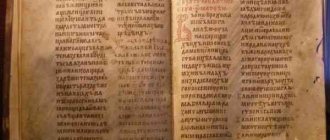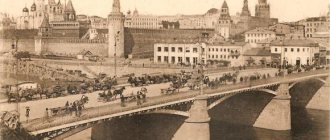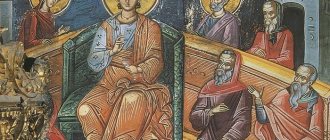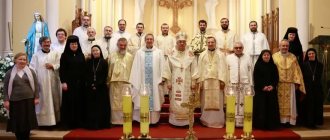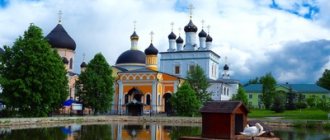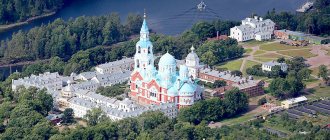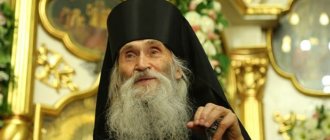By his decree, Bishop Parmen of Chistopol and Nizhnekamsk banned Archpriest Vladimir Golovin from serving in the ministry for:
“... disobedience to the bishop and activities that introduce temptation into the activities of the Church.”
The archpriest did not repent and carried out the orders of the bishop, and now he is awaiting a church court, which, based on the provisions of church law, will decide to remove him from the priesthood. It will be accepted on the basis of the norms of church law, because the Russian Orthodox Church lives, is governed and interacts with the state in accordance with church law.
By the norms contained in church law, the Church protects its God-created system
Scientists define church law as a set of legal norms that have developed during the history of the Christian Church, regulating its internal disciplinary (canonical) life, as well as the relationship of the Church with the state or states.
The Church represents the Kingdom of God on Earth and therefore, from its very creation, manifests its Divine-human nature. That is why it is different from all other human societies.
Church court in Russia in the 17th century. D.F.Poloznev. 1800s. The Church as a Divine institution is not subject to earthly laws, but is subject to those orders that are established on earth. Therefore, there is church law and church court
The Church is a Divine institution and in it the Holy Spirit gives people grace for their salvation and spiritual rebirth. Despite the fact that the Church of Christ is a Kingdom not of this world (John 18:36), it is clearly present in the visible world.
From an everyday point of view, it represents a human community united by a single faith, God's law and the Holy Sacraments.
The Church is not subject to earthly laws, but is subject to the conditions of the order established on earth.
That is why the Church is not subject to any earthly laws, but is subject to the general conditions of the earthly order. This is especially evident in the relationship between the Church and the state. This is quite enough to introduce her to the field of law.
At the same time, legal regulation concerns not only these relations, but also covers intra-church life, the structure of the Church, relationships between church communities and institutions, as well as between individual members of the Church.
Sermon on the Mount, Karl Heinrich Bloch. 1877 In the New Testament, the Church of Christ represents Jesus Christ and those who follow Him. During the Sermon on the Mount, Christ gave his disciples the rule and dogmas of faith, thereby founding the Church
Since the Christian Church was established by the Creator and its Head Jesus Christ gave it His law, namely: the rule of faith and dogmas of faith (moral law), church governance occurs according to special rules.
These rules, some of which were issued by the Church itself with the authority that Christ entrusted to it, form the body of church law. By its norms the Church protects its God-created order.
Initially the church was subject to secular laws
In the ancient church there was no church legislation. The fact is that the entire organization in it consisted of self-government of spiritual communities. Only from the 3rd century did such communities begin to form a clergy, that is, a body of church ministers endowed with special religious and sacred rights.
At the same time, the leaders of Christian communities - bishops - became professional clergy.
Flavius Valery Aurelius Constantine. Roman Emperor Constantine I the Great. Emperor Constantine recognized Christianity. After this, the church hierarchy began to take shape and church law began to form.
Representatives of the clergy, as a result of the Sacraments, received special rights to perform divine services and perform rituals in relation to the laity. In addition, the structure of the Church itself became more complex, because various church ranks appeared in it.
After the Byzantine Emperor Constantine recognized Christianity at the beginning of the 4th century, a strict hierarchy of the Christian religion began to form.
IV century
the beginning of the formation of church law
Bishops replaced the prophets and began to lead a district consisting of several Christian communities. Here they had both religious and judicial power. In addition, they had the right to “interpret” matters of Scripture and church rites.
Meetings of bishops began to be called synods, and large associations of communities appeared - patriarchates and metropolitanates. At the same time, the Roman bishops received the special status of the vicar of God himself, possessing both secular and ecclesiastical power - the status of the pope.
First Council of Nicaea. Icon. After the first Council of Nicaea, the division of the Christian Church into Western and Eastern began. As a result, Orthodox and Catholic church law differ from each other
During this period, church authorities were delegated from secular authorities the right to be an arbiter not only in church, but also in moral and ethical affairs. It was from this moment that we can talk about the emergence of church law, because previously the Church lived according to the secular laws of the Roman and, later, the Byzantine Empire.
It is worth noting that after the Council of Nicaea in 325, the dogmatic and administrative separation of the Eastern (Greek) Church began. This happened due to the reluctance of its representatives to recognize the supremacy of the popes and the dogma of their infallibility.
In our time, Catholic and Orthodox church law differs significantly
The process of dividing the Christian Church into Western (Catholic) and Eastern (Orthodox) was completed by the middle of the 11th century.
During the Middle Ages in the West, church law had already practically taken shape, since Christian rules began to extend their effect not only to clergy and church workers, but also to all believers.
Troublemaker from Languedoc. Jean-Paul Laurent. 1887 In the Middle Ages, monasteries and bishops acquired the powers of a seigneurial court. Their jurisdiction extended to vassals and subject populations
With the establishment of feudal relations in Europe, the church, monasteries and bishops acquired the powers of a seigneurial court in relation to vassals, subject populations and dependent classes.
Subsequently, canon law began to play a major role in the legal system of Western Europe. It regulated almost all spheres of not only church life, but also secular society.
As for Orthodoxy, the eastern branch of Christianity has never claimed primacy over state power. This is why the legal norms of the Orthodox Churches differ from the Catholic ones.
Orthodox Churches have their own ecclesiastical courts.
So the Orthodox Churches have their own ecclesiastical courts, but they do not interfere with secular legal proceedings and secular law. It is worth noting that the norms of Church law applied not only to clergy, but also to secular persons (laity).
The church court considered a wide range of cases (civil, matrimonial, inheritance disputes, etc.), but did not replace the secular one.
A short list of differences between Catholic and Orthodox law is as follows:
- The Pope is considered infallible, so the decisions of the Catholic Church prevail over the decisions of secular courts. Orthodox Patriarchs are not considered infallible and therefore do not place themselves above secular power.
- The ecclesiastical courts of the Orthodox Churches do not interfere in secular life. The courts of the Catholic Church hear a wide range of cases falling within the jurisdiction of secular courts, for example, cases relating to matrimonial relations.
- In some Catholic countries, the Church is part of the state and therefore performs state functions. In Russia, the Church is separated from the state.
Pope Pius IX (1846–1878), during whose pontificate the doctrine of papal infallibility was adopted at the First Vatican Council.
The dogma of the infallibility of the Pope is one of the reasons for the differences between Catholic and Orthodox church law. Naturally, the state, especially in the Middle Ages, often borrowed the norms of church law and allowed their use. For example, to regulate family or marriage relations, the rules established by the Church were applied.
At the same time, primacy has always belonged to the state, because in the eastern branch of Christianity there was no institution of the infallibility of Patriarchs. This tradition comes from Constantinople, where the power of the emperor in secular affairs was always placed above the power of the patriarch.
I. Sources of church law
Since the new rules issued by the Local Councils are no longer included in the canonical code, and, due to the constantly changing circumstances of church-political life, the need for church law-making has not disappeared, interpretations of the canons become especially important. Even the resolutions of the councils of this era sometimes take on the character of interpretations of ancient rules. The interpretations of canons and laws were called scholia by Greek jurists, and glosses by Latin jurists.
Initially, scholia were written in the margins of manuscripts containing the texts of the rules; they were in the nature of comments and explanations concerning individual words or passages of the canon or the entire text. But over time, some of the most ancient scholia were added to the text of the rules or even became independent rules themselves. For example, the 60th canon of the Laodicean Council is not a conciliar canon in origin, but a later scholium on the 59th canon. Rule 60 is not in the oldest lists of the Council of Laodicea. Rule 12 of St. Gregory of Neocaesarea is also, in fact, a later scholia, composed of the 56th and 75th rules of St. Basil the Great. As for the antiquity of the scholia, the German Catholic scholar Hergenrether discovered the following: in one of the manuscripts of the Munich library there is a scholia belonging to Patriarch Photius118.
The ancient scholia were used in their interpretations by the great canonists of the 12th century Aristinus, Zonara, and Balsamon.
There is no consensus regarding the chronological sequence of appearance of their interpretations in science. The last, of course, was the work of Balsamon: in his interpretations of the Nomocanon, he directly names his predecessors Zonaru and Aristin. But the question of who wrote the interpretations first: Zonara or Aristin seems difficult. Until the 19th century, the prevailing opinion was that the work of Zonara preceded the work of Aristin. Beveregius dates the time of Zonara’s activity to the reign of Alexius Komnenos119. Archimandrite John (Sokolov) indicates the year 1120 as the approximate time of Zonara’s writing of interpretations on the “Syntagma”120. Professor of the Moscow Theological Academy A.F. Lavrov, later Archbishop Alexy of Vilna121, considered Zonaru to be Aristin’s predecessor. However, in the second half of the 19th century, most scientists began to be inclined to believe that Aristin wrote interpretations of the Synopsis before Zonara’s work. This point of view is shared by Tzaharie von Lingenthal, A. S. Pavlov, N. S. Suvorov, M. E. Krasnozhen122.
Alexy Aristin is a native of Hellas. He received a legal education and held a high civil position when he was summoned to the capital by Emperor John Comnenos. In Constantinople, Aristinus, in the rank of deacon, occupied the highest government positions of nomophilax, orphanotroph, and, finally, the ecclesiastical position of great steward of the Patriarchal Church. He died after 1166. In the acts of the Council of Constantinople in 1166, the economist Alexy is mentioned among those present at the council.
On behalf of Emperor John, Aristin compiled an interpretation of the canonical “Synopsis” (circa 1130). Due to the brevity of the rules in the Synopsis, there were many ambiguities and inaccuracies in it. There are also errors in conveying the content of the canons. But due to its brevity, “Synopsis” is easy to use and therefore has received the widest distribution. This circumstance explains the choice of this particular canonical collection for commentary.
In his interpretations of the Synopsis, Aristin used the full text of the rules and included excerpts from them in his comments. He also used the ancient scholia on the canons. Occasionally he makes reference to civil laws in church matters. In his interpretations, Aristin explains the literal meaning of the rules, without going into casuistic subtleties.
According to Professor M.E. Krasnozhen, Aristin “follows a strictly dogmatic method: in most cases he explains only the literal meaning of the rules, while indicating how some inaccurate and unclear words and expressions found in the “Synopsis” of the rule should be understood”123 .
If the same subject is spoken of in different rules, Aristin gives them a general interpretation. Only occasionally does he go beyond explaining the literal meaning of the canons and makes comments regarding the reasons that prompted the publication of certain rules, or regarding the use of certain canons not as church-wide legal norms, but only in individual Local Churches. He also draws attention to those rules that have fallen out of use. In cases where the text of the “Synopsis” is clear, Aristin makes the remark: “σαφης” (clear), in “The Helmsman” - “everything is reasonable.”
In the hands of Aristinus was a list of the “Synopsis”, which did not set out the entire “Syntagma” of Photius’ “Nomocanon”: the rules of the Councils of Constantinople of 861 and 879 were missing, and from the rules of the holy fathers only three “Canonical Epistles” of St. Basil the Great were included. In some of Aristin’s lists, however, those rules that were not included in the “Synopsis” are given, without interpretation or presentation. According to A.S. Pavlov, the additions were made by Aristin himself124.
For the history of Russian church law, the “Synopsis” with interpretations by Aristin is of particular importance, because it was he who formed the basis of our “Helmsman”.
Another famous Byzantine canonist, John Zonara, under the emperors Alexis and John, served as the great drungari of the villa, that is, the head of the palace guard, the first secretary of the empire and the vice-chairman of the Imperial Tribunal, the chairman of which was the basileus himself.
Dejected by grief over the death of his wife and children, bored with court intrigues, he took monastic vows. The place where John Zonara was saved was, according to some sources, Athos, and according to others, the monastery of St. Glyceria. Here he, away from the bustle, indulged in literary works. John Zonara wrote an interpretation of the Sunday canons of St. John of Damascus, the canon of the Blessed Virgin Mary, the homily on the veneration of the cross, the life of St. Sylvester, a treatise on marriage law, a treatise on involuntary desecration, and two particularly significant works: “Chronicle from the Creation of the World to 1118” and “Interpretations” to the full “Syntagma” of Fotiev’s “Nomocanon”.
Interpretations on the “Syntagma” of Photius’ “Nomocanon” were probably compiled in the first years of the reign of Manuel Komnenos (1142 – 1181). Before the cathedral rules, Zonara placed brief historical information about the Councils. Zonara explained the meaning of the canons from three points of view: historical, dogmatic and practical. According to A. S. Pavlov, “since the Syntagma contained canonical material that had been formed over many centuries, much here was no longer incomprehensible to the Greeks of the 12th century or received a completely different meaning in practice. Thus, the interpreter had to explain the original, historical meaning of the rules of certain canonical terms and indicate the circumstances that gave rise to this rule. The ultimate goal of Zonara’s interpretations was to extract from them a general position, as a canonical dogma, through the demolition of rules relating to the same subject.”125
When faced with imaginary or real contradictions in the rules, Zonara sought to reconcile and harmonize them. At the same time, as M.E. Krasnozhen noted, he proceeds “from the assumption that the rules contained in one code, based on the same religious and moral principles, cannot contradict each other”126. In his interpretation of the 14th Apostolic Canon, Zonara writes: “One should not think that the canons give contradictory definitions.” In his opinion, in most cases the idea of a contradiction between the canons arises in the reader due to inaccurate formulations.
In the case of a truly irremovable discrepancy in the rules of the Zonar, when deciding whether to prefer the norm of one of the discordant canons, the Apostolic Rules are put in first place; he gives preference to the rules of the Ecumenical Councils over the rules of Local Councils, and they, in turn, place them above the patristic canons. In addition, Zonara proceeds from the legal principle “lex poterior derogat priori” (a subsequent law repeals the previous one). He is also inclined to give preference to the rule that is “more humane,” that is, contains a milder sanction.
Having established the canonical dogma, Zonara explains the incidents of church-canonical practice and provides historical details. Thus, in his interpretation of the 13th canon of St. Basil the Great, he wrote: “Our fathers did not charge killing in battle as murder, excusing, as it seems to me, the champions of chastity and piety. But perhaps it would be good to advise that they, as having unclean hands, should refrain from communing only the Holy Mysteries for three years.” Zonara cites an incident from history: “When Emperor Nicephorus Phocas began to demand that those killed in war be numbered among the martyrs and, like them, be honored and glorified, the then bishops imagined for their part that such honoring would be unfair, and without being heard, Finally, they used the words of Basil the Great, as a rule, saying: “How can we count among the martyrs those who fell in war, when Basil the Great excommunicates them from the Sacrament for three years, as having unclean hands?”
John Zonara composed interpretations only on the “Syntagma”, and not on the first part of the “Nomocanon”, which contains civil laws about the church. Therefore, he does not examine in detail the question of the relationship of canons to laws. But the general nature of his ecclesiastical legal views is clear: he certainly puts canons above laws.
In his judgments about modern life, Zonara shows rare fearlessness. In his explanation of the 28th rule of the Council of Chalcedon, he writes: “The royal power has turned into tyranny, and the Senate is constrained and has lost its importance.” In his interpretation of the 7th rule of the Neocaesarea Council, which prohibits the presbyter from feasting at the marriage of a bigamist, Zonara notes: “But so in the letter, and we see both the patriarch and various metropolitans feasting with the king who entered into a second marriage.”
Zonara's scientific rigor deserves high praise. He is always cautious in his conclusions, and where the resolution of the issue, due to the insufficiency of the material at his disposal, exceeds his capabilities, he openly admits this.
According to the description of M.E. Krasnozhen, “the language in which the interpretations are written (interpretations of Zonara - V. Ts.) is distinguished by clarity and simplicity, but this simplicity does not prevent ... Zonara’s speech from being very beautiful and figurative. Sometimes Zonara begins an interpretation with words that serve as an epigraph to him, likes to resort to comparisons and juxtapositions, takes the opportunity to cite well-known truths of a moral nature, sometimes borrowing them from poets and sages, and, especially often, looks for evidence of the validity of his words in the Holy Scriptures.” 127.
The last, but probably the most authoritative, canonist of the 12th century was Theodore Balsamon. He was born in Constantinople, the capital, and began his ministry to the Church. Under Emperor Manuel, he already held the positions of patriarchal nomophilax and chartophylax. Balsamon became famous as an expert in ecclesiastical and secular law, and this fame contributed to his elevation to the Patriarchal throne of Antioch in 1193 under Emperor Isaac Angelos. But Balsamon did not leave Constantinople, for Antioch was then occupied by the crusaders.
According to the story of Nikita Choniates, Emperor Isaac Angelos, wanting to elevate Patriarch Dositheus of Jerusalem to the capital see of Jerusalem, who had once predicted the imperial purple for Isaac, turned to Theodore Balsamon with the words that he would like to transfer him from the Antioch see to the Constantinople see, but, unfortunately, this the canons do not allow. But if he, an expert in the canons, could prove that such a transfer was legal, the emperor would immediately order his transfer. Theodore Balsamon found that this issue could be resolved. When his explanations were presented to the council of bishops, an imperial decision followed on the transfer of the Patriarch of Jerusalem Dositheus to the capital's see, and Theodore Balsamon remained the Patriarch of Antioch.
Balsamon received the order to compile interpretations for the entire “Nomocanon in the XIV Titles”, and not just for one “Syntagma”, even before his patriarchate from Emperor Manuel. The main motivation for this work was the discrepancy between the laws of Justinian, included in the Nomocanon, and the legislation then in force in Byzantium, based on the Basilicas.
The direct reason for this work was the following incident. Patriarch Michael of Constantinople, without the consent of Metropolitan Leo of Amasia, who for a whole year did not fill one episcopal see in his metropolis, installed a bishop on it, referring to the 1st chapter of the 123rd novel of Justinian, which was included in the 1st title of the “Nomocanon” " They objected to the Patriarch: the novella had lost its validity because it was not included in “Vasiliki,” and the Patriarch insisted that the “Nomocanon” is a sacred book and therefore cannot lose its force. The Emperor and the Senate spoke out against the Patriarch.
And so, in the interpretations of the Nomocanon, Balsamon had to answer the question about the legal force of the laws included in the Nomocanon, but not included in the Basiliki. And Balsamon recognized them as having lost their power. Therefore, in his interpretations, he had to clearly distinguish which of Justinian’s canons was accepted in “Basiliki” and which was not accepted.
In his explanation of the Syntagma, Balsamon relied mainly on Zonaru. He often repeated his interpretations verbatim. But, according to A. S. Pavlov, Valsamon “becomes completely original in those cases when it was necessary to establish the relationship of church canons to state laws and to reconcile the disagreements between both, or to resolve some casuistic issue that arose in modern church practice "128.
Balsamon proceeds in his comments from the principle that laws must yield to canons, but his argumentation is particularly sensitive to the legislative power of the state. He places canons above laws, since the former have a double sanction: from Church Councils and from the emperors themselves, and the latter - only from the emperors, thereby freeing himself from the need to insist on the priority of church power in itself over the imperial one.
In contrast to Zonare, who always relies on the canons and criticizes deviations from them in modern church practice, Balsamon everywhere tries to prove that contemporary church practice does not contradict the holy canons. He certainly justifies all the actions of emperors in matters of church government. Balsamon also vigorously defends the advantages of the Patriarch of Constantinople in comparison with other Patriarchs (interpretations of the 31st canon of the Holy Apostles, 10th canon of the VII Ecumenical Council, 1st canon of the I Ecumenical Council), often resorting to exaggerations.
Balsamon's apologetic attitude towards the current church law of Byzantium strengthened his authority. Already at the end of the 14th century, Patriarch Philotheus called him the most skillful canonist, whose voice solves the most confusing issues. This authority is also based on the amazing learning of Balsamon, on his excellent knowledge of ecclesiastical and secular law, and on his rare skill in reconciling conflicting legal norms.
In addition to the interpretations of the “Nomocanon in the XIV Titles,” Theodore Balsamon compiled 66 canonical answers to the questions of the Patriarch of Alexandria Mark, which were included in the “Athenian Syntagma.”
The interpretations of Aristin, Zonara and Balsamon, authorized by the highest ecclesiastical authority, merged with the canonical code of the Orthodox Church. Already in the 13th century, the uncommented lists of the Nomocanon were considered obsolete and began to fall out of use.
Differences between ecclesiastical and secular law
The main task of secular law is to regulate social relations by adopting generally binding norms and rules in the prescribed manner. That is why the state implements its two most important functions through law: coercion and punishment.
If a person refuses to comply with established rules of conduct (laws), the state forces him to do so, and punishes violators.
A group of prisoners under escort delivering goods to a prison. Eastern Siberia, early twentieth century. Church law, in contrast to secular law, is based on the dogmas that Christ gave to the Church. That is why the goals of punishment in the Church and the state are different
The right of the church is based on those rules and regulations that were given by the Savior. Therefore, it implements such methods of legal regulation as akrivia and oikonomia. Akrivia is a way of resolving controversial issues based on the position of strict adherence to the principles of Christian teaching.
It is used to resolve disputes regarding the fundamental dogmatic principles of church life, about the very essence and purposes of the existence of the Church and Christianity.
Oikonomia is a method of legal regulation that allows for leniency towards human infirmities and weaknesses in ecclesiastical, practical and pastoral issues that are not of a dogmatic nature.
In the Russian Federation, the Church is separated from the state on the basis of Art. 14 of the Constitution.
In our time in Orthodoxy, church law regulates exclusively intra-church issues. These are: problems of church structure, compliance or non-conformity of the behavior of clergy with church canons, relationships between Local Churches, relationships between Church and State, etc.
At the same time, it is necessary to remember that in Russia the Church is separated from the State in accordance with Article 14 of the Constitution of the Russian Federation.
His Holiness Patriarch Kirill of Moscow and All Rus' and President of the Russian Federation Vladimir Putin. Despite the fact that Orthodoxy in Russia is recognized as one of the traditional religions, the Church is separated from the state on the basis of the relevant provisions of the Constitution
The Church is considered by the State as one of the forms of public associations. That is why in economic activities it is guided by secular laws. In addition, the Church in Russia pays taxes and fulfills other duties assigned to it by Russian laws.
At the same time, there is no doubt the influence of church institutions and Christian dogmas on secular law, which is manifested, for example, in the institution of pardon or amnesty.
Briefly, the differences between secular and ecclesiastical law can be displayed as follows:
- Secular law is aimed at forcing citizens to comply with the rules of conduct adopted through regulatory legal acts. The purpose of church law is to encourage a person to carry out spiritual work on himself in order to get closer to God.
- Secular law is based on those provisions adopted by state authorities, church law - on dogmas given by God.
- Secular law, among other things, regulates the relationship of the Church, as a public organization, with other legal entities. Church law has as its sphere of regulation a narrow range of issues relating to internal church life, and does not affect other areas of legal regulation.
Canon law
Section V. CHURCH AUTHORITY.
- The nature of church power and its differences from secular power.
- Types of church authority.
- The power of teaching:
- Creed and other authoritative statements of doctrine.
- Sermon.
Tutorial:
Archpriest Vladislav Tsypin, Canon Law. – 2nd ed. – M.: Sretensky Monastery Publishing House, 2012. – 864 p.
Materials:
Episcopal oath
Symbol of Gregory of Neoscesarius
Symbol of Athanasius the Great
Epistle of the Patriarchs of the Eastern Catholic Church on the Orthodox Faith (1723)
May 8, 2021
Topic: Church and state.
- Orthodox teaching on the state P. 754
- Models of relationships between Church and state p. 768.
- Relations between the Church and the state in Russia. P. 791
Tutorial:
Archpriest Vladislav Tsypin, Canon Law. – 2nd ed. – M.: Sretensky Monastery Publishing House, 2012. – 864 p.
Materials:
Plato. "State"
Exercise:
Prepare a discussion on one of the given topics (2-3 A4 sheets):
- Models of church-state relations.
- Byzantine doctrine of the symphony.
- State legislation on religious associations of the Soviet era.
Send completed assignments by e-mail with the subject line “Canon Law” by May 11, 2021.
May 12, 2021
Topic: Church and state.
- Relations between the Church and the state in the Soviet era. P. 799
- Constitutional status of the Russian Orthodox Church. P. 808.
- The status of the Russian Orthodox Church in accordance with the Federal Law of September 26, 1997 “On freedom of conscience and religious associations. 810"
Tutorial:
Archpriest Vladislav Tsypin, Canon Law. – 2nd ed. – M.: Sretensky Monastery Publishing House, 2012. – 864 p.
Materials:
Law on Freedom of Conscience and Religious Associations
Exercise:
- Read the material.
- Know the Law on Freedom of Conscience and Religious Associations, be able to communicate.
May 15, 2021
Topic: Church and state.
- Legislative acts regulating church life (p. 815).
- Prospects for the development of Russian legislation on the status of religious communities (p. 816).
Tutorial:
Archpriest Vladislav Tsypin, Canon Law. – 2nd ed. – M.: Sretensky Monastery Publishing House, 2012. – 864 p.
Exercise:
- Read the material.
========================================================================
May 19, 2021
Topic: Basic principles of the relationship between Church and State.
- Canonical norms of relations between Church and State. P. 817
- Relationships between clergy and government. P. 822.
Tutorial:
Archpriest Vladislav Tsypin, Canon Law. – 2nd ed. – M.: Sretensky Monastery Publishing House, 2012. – 864 p.
Exercise:
- Read the material.
- Be able to navigate the principles of the relationship between Church and State.
========================================================================
May 22, 2021
Topic: Basic principles of the relationship between Church and State.
- The Orthodox Church in the modern world (p. 825).
Tutorial:
Archpriest Vladislav Tsypin, Canon Law. – 2nd ed. – M.: Sretensky Monastery Publishing House, 2012. – 864 p.
Exercise:
- Read the material.
========================================================================
May 26, 2021
Topic: Sources of law of the Catholic and Protestant churches.
- Features of legislation and sources of law of the Catholic Church (p. 826).
- Medieval Catholic collections of canon law (p. 831).
- Codes of the Catholic Church (p. 835).
- Legal sources of Protestant churches (p. 839).
Tutorial:
Archpriest Vladislav Tsypin, Canon Law. – 2nd ed. – M.: Sretensky Monastery Publishing House, 2012. – 864 p.
Exercise:
Read the material, be able to navigate.
========================================================================
May 29, 2021
Topic: Higher government of the Roman Catholic Church (pp. 840 – 846).
Read the material.
Church law is based on an extensive body of legal sources
The sources of church law are very diverse, but their basis is the Holy Scripture. The main set of them dates back to the era of the Ecumenical Councils, when the main church canons were formed. In our time, the hierarchy of law operating in the Russian Orthodox Church is as follows:
- Canonical Code of the Ecumenical Orthodox Church - Rules of the Holy Apostles, Councils and Fathers. They are included in the Pidalion, the Athenian Syntagma and, translated into Slavic-Russian language, in our Book of Rules.
- “The Statute of the Russian Orthodox Church,” adopted at the 1988 Council, replacing the “Regulations on the Russian Orthodox Church,” issued by the 1945 Council.
- Definitions of the Council of 1917-1918 retaining legal force in that part of them that has not been formally canceled, has not been replaced by new norms of the “Charter” and does not contradict the existing conditions of church life.
- Determinations of the Holy Synod and Decrees of His Holiness Patriarchs, Patriarchal Locum Tenens and Deputy Patriarchal Locum Tenens in the case when they have not been canceled or become outdated.
First Ecumenical Council.
Sketch for the painting of the Cathedral of Christ the Savior in Moscow. 1876 Artist V.I. Surikov. At the First Ecumenical Council, many documents were adopted that became the main sources of church law. It must be remembered that in the new state-legal conditions, the external position of the Church in the state is determined by modern state legislation.
Thus, all church legislation of the synodal and pre-synodal era has retained its force to the extent that it has not been repealed, changed or outdated, and also if it does not contradict the current legislation of the Russian Federation.
Modern church law of the Russian Orthodox Church recognizes parts of the “Helmsman’s Book” as its source.
The heterogeneous material that was previously included in the “Helmsman’s Book” (Nomocanon) is worthy of special consideration. The fact is that some of the laws of the Byzantine emperors entered Russian law through it.
That is why they retained their strength regardless of the state power operating in Rus' and in Russia.
“Nomocanon” by Patriarch Photius I of Constantinople. In Russia, this work was called “The Helmsman’s Book.” Some of its sections are still used in modern church law
To a greater extent this concerns church marriage law, which is very little regulated by church canons. Thus, among almost all Local Churches, the following definition of marriage has been accepted, formulated by the Roman jurist Modestinus (III century) and placed in the “Nomocanon” of Patriarch Photius I of Constantinople: “Marriage is the union of a man and a woman, the communion of life, participation in divine and human law.”
In addition, the “Helmsman’s Book” contains and is used in our time the legal norms that determine the highest governance in the Russian Orthodox Church, since the canonical structures of the universal Church are unshakable at all times.
Study of church law in Russia and the Balkans.
In Rus', church law in ancient times was studied exclusively for practical purposes. The first experiments in its scientific study date back to the beginning of the 19th century. Only at the end of the 18th century was the teaching of church law introduced at the Moscow Theological Academy. The instructions compiled by Metropolitan Plato recommended reading and interpreting the “Helmsman’s Book”, comparing the Slavic translation with the original text of the canons. In 1798, the Holy Synod ordered the teaching of “The Helmsman” in all Theological Academies. After the reform of the theological school in 1808, the teaching of a course in canon law was introduced in academies. Teachers were entrusted with the responsibility not only to systematize the canonical material, but also to scientifically process it. Since 1835, canon law began to be taught at university law faculties.
Metropolitan Philaret (Drozdov) did not leave works specifically devoted to canon law, but his reviews and judgments on various issues of church and state life, carefully collected and published after the death of the saint, are of invaluable importance for every canonist. Metropolitan Philaret knew and subtly understood church rules and relied on them both in his archpastoral service and in his theological views.
The author of the first Russian textbook on our discipline is Archpriest I. Skvortsov, who read canon law at the Kiev University of St. Vladimir.
The first serious attempt at not a compilation, but a scientific presentation of the system of church law belongs to the famous preacher, canonist and theologian Bishop John (Sokolov). His work, published in 1851, is entitled “Experience in a Course in Church Jurisprudence.” Bishop Nikodim (Milash) of Dalmatia calls him “the father of the new science of Orthodox church law.” Bishop John's course is distinguished by clarity of presentation, theological depth of interpretation of ancient canons, and insightful historicism in the assessment of sources. According to Archpriest G. Florovsky, in his “Experience” “for the first time, ancient and fundamental church canons were proposed in Russian with a detailed and interesting commentary.” Bishop John wrote a number of articles on certain canonical issues, including the treatise “On the Monasticism of Bishops.” In it, he emphasizes the need for the bishop not only of formal monasticism, but also of internal ascetic renunciation of the world.
In 1874-1875 A course by Moscow University professor N.K. Sokolov “From lectures on church law” has been published. These lectures, according to A. S. Pavlov, “were distinguished by remarkable clarity of presentation and a fairly solid legal presentation of the subject.”
The most complete of the textbooks on church law belongs to the professor of the Kazan Academy and University I. S. Berdnikov. It was published in 1888 and was entitled in a strange way - “A Short Course in Church Law.” According to A. S. Pavlov, I. S. Berdnikov’s textbook “is not entirely successful in its system and is more theological than legal in nature.” But the focus on the theological interpretation of the canons, which is not entirely common for Russian manuals on the canons, is not a disadvantage, but rather its advantage.
The “Course of Church Law” by professor of the Yaroslavl Law Lyceum N. S. Suvorov, first published in 1888-1890, and subsequently revised into the “Textbook of Church Law,” which was reprinted many times, is widely known. N. S. Suvorov is a qualified lawyer who had excellent knowledge of the sources of canon law and the history of church institutions, especially Western ones.
At the same time, his work suffers from significant theoretical and methodological flaws. A convinced apologist for the synodal system, N. S. Suvorov builds his course not so much on the canons, but on the laws and orders of the Russian government for the Office of Orthodox Confession. This approach stems from his belief that the sovereign head of the Church is the monarch. Transferring his ideas generated by Protestant theories of state law to the ancient Church, N. S. Suvorov writes: “For the Church, as the Catholic Church (sic, not catholic - V.D.), universal, embracing the entire totality of Christian communities and coinciding, although and not literally, with the borders of the Roman Empire, in the same way there had to be a known visible one to whom the most important church orders would be sent, just as the Roman Empire itself could not do without a central power. This center became the imperial power.” Caesar-papism, which heterodox polemicists unjustifiably attribute to Orthodoxy, N. S. Suvorov considers the norm of relations between state power and the Church. It is also puzzling that he presents the law of the Orthodox Church on an equal basis with the law of the Catholic and Protestant churches.
The most successful Russian guide to the canon is A. S. Pavlov’s “Course of Church Law,” posthumously published from student notes of his lectures at Moscow University in 1902. It is written in good, lively language, not particularly characteristic of legal literature, and is distinguished by a well-thought-out system of presentation , and most importantly, the strictly Orthodox position of the author, which is combined with thorough legal competence.
This does not mean, of course, that A. S. Pavlov’s “Course” is without shortcomings. The following circumstance raises an objection: he considers the Ecumenical Council only as one of the bodies of relations between local Churches. This manifested a tendency characteristic of the canons of modern times, the focus of which is not the Ecumenical, but the local Church. A. S. Pavlov’s “Course” also has another drawback, characteristic of almost all Russian manuals on church law - the ancient canons in them do not form the main subject of presentation, being relegated to the background by later legislation. As a result, the rules of the Holy Fathers and Councils on repentant discipline, which occupy such an important place in the canonical code, are considered in passing in the educational manuals of the synodal era, mainly through the prism of the instructions of the Spiritual Regulations.
Of the individual branches of church law in Russian science, especially many successful studies relate to source studies. The first serious work in this area belongs to Metropolitan Evgeniy (Bolkhovitinov), who compiled the “Historical Review of Russian Legislation” (1825)
In 1839, the second edition of the study by St. Petersburg lawyer G. A. Rosenkampf “On the Helmsman’s Book” was published posthumously. Rosenkampf carefully researched and divided into categories and surnames all the lists of “Helmsmen” available to him.
The famous archaeographer and source scientist N.V. Kachalov in 1850 published the work “On the significance of Helmsmen in the system of ancient Russian law.” He included the study of “The Helmsman” in the general context of church law of pre-Petrine Rus', indicating the purpose of the study - “to determine in a brief overview the legal significance of the clergy in Russia and its relationship to secular power in the period before Peter the Great: this will explain to us the nature and content, and together with This is the practical significance of “The Helmsman,” written in our country.”
In the second half of the 19th century, a number of source studies by A. S. Pavlov were published: “The Initial Slavic-Russian Nomocanon” (1869), “Lawful Books” (1885), “Nomocanon at the Great Trebnik” (1872). Based on his archaeographic and textual research, A. S. Pavlov came to the conclusion that the “Nomocanon of the XIV Titles” was translated into the Slavic language later than the Slavic translation of the “Nomocanon” by John Scholasticus. This translation was known in Rus' already in the 11th-12th centuries.
The textual study of the ancient parchment copies of the Helmsman is associated with the name of the major paleographer and philologist I. I. Sreznevsky, who published a number of articles on Serbian and Russian reviews of the Helmsman in 1870-1890. In 1891, a review of source studies by N. A. Zaozersky “Historical Review of the Sources of Law of the Orthodox Church” was published in Moscow.
The most brilliant achievements of Russian source studies of church law are associated with the works of the 20th century canonist V. N. Beneshevich (1874-1943). He owns the textologically impeccable publications of the most important monuments of church law: “Synagogues in 50 titles” by John Scholasticus and “Syntagmas in XIV titles.” The scientist set out to find out how to explain the almost complete absence of imperial short stories on church affairs in these monuments: the loss of sources or the fact that the short stories were not recognized by the Church as laws binding on it. A scrupulous study of handwritten sources led him to the conviction that, unlike Justinian’s Code, not a single imperial law of the iconoclastic era (VII-IX centuries) was recognized as a general church norm. He outlined these conclusions in the book “Canonical Collection of XIV Titles from the Second Quarter of the 7th Century to 883” (1905). The great merit of V.N. Beneshevich is the publication of the text of the Slavic “Helmsman” in XIV titles in parallel with Greek sources.
V.N. Beneshevich continued his research in the 20s and 30s. In the Sofia collection “News of the Bulgarian Archaeological Institute” (1935), he published the article “Corpus scriptоrum juris graeco-romani tarn canonici quam civilis” (Corpus of monuments of Greco-Roman law, both canonical and civil), where he wrote about , that the study of the ancient “Helmsmen” “will reveal new and important facts in the history of cultural development in relation to Byzantium, the south of the Slavs and ancient Rus'.” Some of this author's works have remained unpublished and are kept in archives.
A major specialist in the sources of ancient Russian church law was S. V. Yushkov (1888-1952). Also worthy of attention are the source studies of the modern scientist Ya. N. Shchapov, devoted to the study of the Slavic and Russian editions of “The Helmsman,” as well as the princely charters and statutory charters of the Church.
Among the works devoted to private issues of the canons, the monographs by N. S. Berdnikov “State position of religion in the Roman-Byzantine Empire” (1881), the work of N. A. Zaozersky “Church court in the first three centuries of Christianity” (1878) are of great interest g.), article by A. P. Lebedev “The meaning of the canons,” church canonical works of M. V. Zyzykin, professor of the department of church law at the University of Warsaw.
Along with V.N. Beneshevich, one of the largest canonists of our century was S.V. Troitsky, whose first works appeared at the beginning of the century, and the last were published in the 60s. His research is devoted to issues of autocephaly, criticism of papist tendencies in the church policy of the Patriarchate of Constantinople, the problem of schisms, marriage law, and the history of canonical sources.
A serious study on the structure of the Ancient Church is the monograph of Archbishop Lollius (Yuryevsky) “Alexandria and Egypt,” written in the 20s and published in our time.
A great contribution to the development of church legal consciousness are the articles of Patriarch Sergius; both those that he wrote at the beginning of the century, and those published in church publications in the 30-40s, as well as his correspondence with Russian bishops dating back to the 30s. The subject of particular interest of Patriarch Sergius was the organization of higher church administration. He devoted a number of articles to the problems of relations between the Orthodox Church and heterodox societies. In developing this ecclesiological theme, he relied on church canons, giving them a deep theological interpretation.
Among the Serbian canonists, the largest name is Bishop Nikodim (Milash) of Dalmatia. “The Canons of the Orthodox Church” with thoughtful, extensive commentaries, published by him in 1895-1899, were the result of careful research. Until now, canonists use this work, which has not lost its scientific and practical value, although, of course, some interpretations of Bishop Nicodemus need to be revised. His work “Orthodox Church Law,” translated soon after its release into Russian and German, is distinguished by a strictly ecclesiastical interpretation of the canonical heritage. It includes detailed information about the structure of the autocephalous Churches at the end of the 19th century.
Also worthy of mention are the names of famous Romanian canonists of the 19th century - Bishop Andrei (Shaguna), K. Popovich, the Bulgarian canonist and theologian of our century - K. Tsankov.
The systematic study of church law in Russia began in the 17th century.
As a science, church law studies quite complex issues. For example, the division into church law proper (jus ecclesiasticum) and canon law (jus canonicum) is still considered a controversial subject.
Some theologians produce the first from the Church during the era of the Ecumenical Councils in the East and until the end of the Middle Ages in the West, regardless of whether it concerns church or civil affairs. Others argue that canon law is the law concerning the Church, independent of the legislator.
All-Russian Emperor Alexander I. G. Dave. 1826 Under Emperor Alexander I, church law as a theological science began to be systematically taught in theological academies
In Russia, church law began to be systematically studied in the 17th century. Thus, in 1789, a Decree of the Holy Synod appeared, according to which the reading and explanation of the Helmsman's Books and the Book of the Positions of the Parish Priest, as well as such a new science as canon law, were introduced in all theological academies.
Under Alexander I, church law was included in the course of theological sciences and it began to be read in theological academies in a systematic form
Study of church law in Byzantium and Greece.
In ancient times, law was studied in higher schools of an encyclopedic nature: in Athens, Alexandria, Antioch, Beirut, Rome, and later in Constantinople. In these unique universities, where pagan professors predominated even after the publication of the Edict of Milan, Tertullian, Saints Basil the Great, Gregory the Theologian, John Chrysostom, and Ambrose of Milan received a good legal education. In 534, Justinian forbade pagans to teach, and some of the former schools were closed after that. Universities remained only in Rome, Constantinople and Beirut. In 634 the Beirut school also closed.
During the Macedonian dynasty, jurists of the Constantinople school participated in the publication of legislative collections: “Prochiron,” “Epanagogue” and “Basiliki.” Secular and canon law in Byzantium in that era were not separated from one another. The canonists were also experts in civil law.
The first special law school was opened in the Constantinople monastery of St. George in the 11th century. Its head bore the title of nomophilax (guardian of the laws), and all candidates for judicial positions were examined by him. The works of authoritative Greek canonists are associated with the Constantinople school: Alexius Aristinus, John Zonara, Theodore Balsamon and Demetrius Khomatin. Aristin and Balsamon at one time headed it, having the titles of nomophilax.
The study of the canons in Byzantium was predominantly practical rather than theoretical and research in nature. Systematized sets of rules and laws were compiled, a subject classification of legal norms was developed, highlighting headings and subsuming various legislative acts under them. Then explanatory notes - scholia - were added to the text of the rules, in which unclear expressions were interpreted.
Aristinus, Zonara and Balsamon compiled extensive exegetical commentaries on the entire composition of the canonical corpus. Due to the conquest of Constantinople by the Crusaders, the law school was transferred to Nicaea and from there to Ephesus; She returned to the capital only after its release. In the 14th century in Byzantium the famous “Syntagma” was compiled by hieromonk Matthew Blastar and the “Sexateuch” (“Exavivlos”) by the Thessalonian nomophylax Constantine Armenopoulos.
The fall of Constantinople put an end to the successes of church jurisprudence in the Greek East. Only at the turn of the XVIII-XIX centuries. a new canonical collection with interpretations appears - “Pidalion” (“The Helmsman”), compiled by Saint Nicodemus the Holy Mountain and Hieromonk Agapius. The original text of each rule in the Pidalion is followed by its presentation in Modern Greek and commentaries based on the classical interpretations of Aristinus, Zonaras and Balsamon. Numerous notes discuss difficult questions of canon law. The liturgical instructions and pastoral advice contained here are of great interest to clergy. Some canonists consider the Pidalion to be the most perfect and authoritative body of Orthodox church law.
In 1852-1859. edited by Rally and Potli, the 6-volume “Syntagma of the Divine and Holy Canons” was published in Athens. The “Syntagma,” along with the canonical corpus, including the “Nomocanon in 14 titles,” the “Syntagma” of Matthew Blastar and the interpretations of Aristinus, Zonara and Balsamon, also included later legislative acts of the Patriarchate of Constantinople and laws on the Church issued in the Greek Kingdom. Among the works of Greek scholars of modern times, the “Guide to Church Law” by K. Ralli, the monographs of Alivizatos, the studies of Konidaris on the structure of the Ancient Church, the canonical works of one of the greatest theologians of the 20th century Gregory Papamikhailou, the works of the church historian and canonist of our time, Metropolitan Maximus of Sardica ( Christopolous).
A modern textbook on church law was written by Archpriest Vladislav Tsipin
By the definition of the Holy Synod of May 10, 1840, church laws were introduced into theological academies and seminaries as an independent subject.
They also taught church law in universities. In Soviet times, due to persecution and the separation of Church and state, church law was practically not applied.
Archpriest Vladislav Tsypin on the first floor of Sretensky Theological Seminary. Father Vladislav is the author of a modern textbook on church law.
These days there is a revival of interest in this subject. At the same time, it is necessary to remember that all disputes within a particular diocese are resolved by the diocesan administration. It is under him that church courts function.
These are the institutions where the legal activities of the Church are concentrated in our time. Church law itself in Russia is gradually being revived thanks to the works of such experts as Archpriest Vladislav Tsypin, who wrote a modern textbook on this subject.
Textbook of church law by V. Tsypin on the website “Azbuka.Ru”.
By leaving a comment, you accept the user agreement
Study of church law in the West.
The cradle of canonical science in the Catholic West was the law school of the University of Bologna, established in the 11th century. This school was engaged in commenting and codifying Roman law according to the “Corpus” of St. Justinian. Due to the close connection between civil law and canon law, Bolognese jurists turned to the study of ancient canons and papal decretals.
In the 12th century in Bologna, the monk Gratian, following the model of Justinian’s “Institutes,” compiled a canonical compilation “Concordantia discordantum canonum” (Coordination of Discordant Laws), later briefly called the “Decree.” The “decree” formed the basis of the “Corpus juris canonici” (“Corpus of Canon Law”), the official body of Catholic church law.
The “Decree” served as the basis for Bologna jurists for scholarly work similar to that which they carried out in connection with Justinian’s “Corpus.” Lawyers wrote comments - glosses on canons and decretals, which were added in the margins (marginals) or between the lines (interlinear glosses) of sources . Following the method of the Bolognese glossators, canon law was developed in other European universities, especially in Montpellier and Paris.
In the 15th century, the first attempts were made to critically assess the sources of Roman church law. The result was the discovery of forgeries that filled the collection of “False Isidore Decretals,” included in the “Corpus of Canon Law.”
The Reformation dealt a particularly serious blow to medieval Catholic law. Luther sarcastically attacked papal decretals in his sermons and writings; Together with students of the theological faculty of the University of Wittenberg, he solemnly burned the “Corpus juris canonici.” In Lutheran universities, canon law was studied primarily for the purpose of conducting polemics against Catholic doctrines, especially the doctrine of universal papal jurisdiction.
A critical attitude towards medieval canonists was subsequently revealed among Catholic scholars: among adherents of Gallicanism in the 17th century, in German Febronianism in the 18th century, and, finally, among Old Catholics.
In the post-Tridentine era, the study of ecclesiastical law was transferred from theological and law faculties to seminaries. In this regard, it acquired a predominantly practical rather than scientific and theoretical character. Church law was studied in close connection with moral theology, which entailed the transfer of the legal method of formal interpretation of texts to the field of moral theology.
In the 18th century, individual national schools of Catholic canonry were characterized by different areas of research. In Germany the dominant commentary was on the "Corpus of Canon Law;" in Italy - casuistry, a careful analysis of difficult issues of church law; French scholars primarily studied the history of canonical sources and church institutions.
A serious contribution to our science was the critical editions of ancient sources undertaken in modern times in the West. At the end of the 16th century, the German scientist Levenclave (in Latin - Leunclavius) published the sources of Byzantine civil and church law "Jus graeco-romanum" (Greco-Roman law). In 1661, the French Voellus and Justellus (Voellus et Justellus) carried out a critical edition of the ancient canonical collections, Greek and Latin - “Bibliotheca juris canonici veteris” (Library of ancient canon law).
In 1672, the Anglican pastor Beveregius, later a bishop, published in Oxford in two volumes “Σινοδικοη” (Synodikon), a collection of Greek sources of canon law. In the 1st volume he placed the Rules of the Ecumenical and Local Councils with interpretations of Aristin, Zonara and Balsamon, in the 2nd - the “Alphabetical Syntagma” of Matthew Blastar. This publication was used not only in the West, but also in the Orthodox East. With the blessing of the bishops they were read and copied. Beveridge's edition formed the basis of the Greek "Pidalion" and "Syntagma."
In the 1860s. A two-volume edition of the code of canon law, written by Cardinal Pitra, was published in Rome: “Juris ecclesiastici graecorum historia et monumenta” (History and monuments of Greek church law). Pitra provided the texts of the canons with extensive commentaries; The commentator's multifaceted scholarship coexists with outright tendentiousness. His main goal is to prove that in the East, before the division of churches, the pope was recognized as the head of the Universal Church. In textual terms, Cardinal Pitra's edition is superior to all earlier editions. Pitra used the best manuscripts from European libraries, including those in Moscow and St. Petersburg.
The critical editions of the code of canon law of the Ancient Church that appeared in the West made it possible to place canonism at a high scientific level. The main centers of science again, as in the Middle Ages and the era of the Reformation, became theological and law faculties. The best systems and textbooks of church law in the 19th century were written by German scientists Walter, Richter, Hinschius, and R. Som. Among the most significant Western canonists of the 20th century are: Kruzel, Febvre, Martimor, Fournier-le-Bras, Stickler, Leuning, Kurtscheid, Staffa, Fürst.
Of particular interest to us are those works of modern Western scientists who are devoted to the study of the sources of canon law of the Orthodox Church. In the middle of the 18th century, the Ballerini brothers wrote a two-volume work in Latin, dedicated to the history of the sources of law of the Ancient Church before the appearance of the “False Isidore Decretals”. This study is distinguished by its subtle critical analysis of texts, and it has not yet lost its scientific value. The history of the sources of ancient church law is devoted to the works of scientists of the 19th century: W. Bright, Biner, Mortreul, Tzaharie von Lingenthal, I. Chizhman.
In our time, one of the most competent experts on the ancient canons is P. P. Joannou. However, his research suffers from bias. Joannou's efforts to prove that in the Ancient Church the primacy of the pope was not a claim of Rome, but a reality recognized by the Councils and Holy Fathers, are untenable, despite all the sophistication of his argumentation.
A serious contribution to canonical science is the work of the Orthodox French scientist Archbishop Peter L'Huillier: numerous articles, some of which were published in the “Bulletin of the Western European Exarchate,” and the dissertation “Disciplinary works of the first four Ecumenical Councils,” devoted to textual and exegetical commentary on the Rules of the Ecumenical Councils - from Nicene to Chalcedon.
